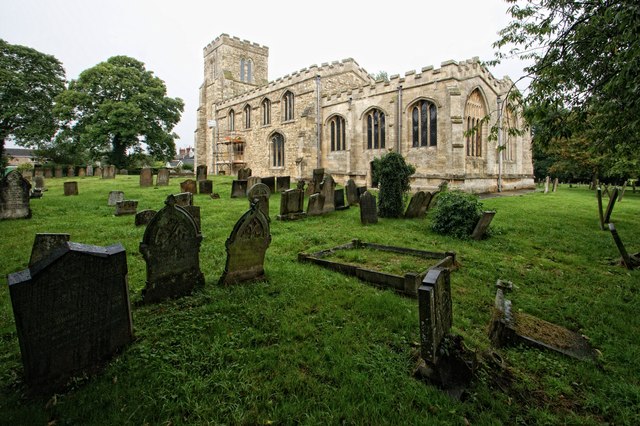The Church of St Botolph, Saxilby-with-Ingleby
Introduction
The photograph on this page of The Church of St Botolph, Saxilby-with-Ingleby by Dave Hitchborne as part of the Geograph project.
The Geograph project started in 2005 with the aim of publishing, organising and preserving representative images for every square kilometre of Great Britain, Ireland and the Isle of Man.
There are currently over 7.5m images from over 14,400 individuals and you can help contribute to the project by visiting https://www.geograph.org.uk

Image: © Dave Hitchborne Taken: 24 Aug 2015
The church is of interest since it has indications of building in four different architectural styles over a period of some 900 years. The oldest part of the present building is the wall of the north aisle. During restoration work in 1929 a doorway was discovered set in a rubble wall covered in plaster. The doorway is believed to be Saxon but is more probably Early Norman since it has a slightly chamfered arch. It must date back to about 1100 and is best seen from the outside. The capitals of the pillars at either end of the arcade of the north aisle are in the Early English style, of about 1200, with 'stiff-leafed' foliage and a moulded abacus above. The central pillars of the north aisle arcade are quatre-foil (four stemmed) in section and are in the Decorated style, which succeeded the Early English, about 1300. The chancel arch is plain Early English. The rest of the building, consisting of the double chancel and clerestoried nave, is in the Perpendicular style, dating from 1350 to 1500. The nave roof is 15th century with moulded principals and carved bosses. The tower was rebuilt in 1908 and contains six bells, four of which were re-hung and two added in 1947. The seven-arched oak chancel screen contains most of its original 15th century tracery. Stairs, which once gave access to the rood screen, may still be seen at the east end of the north aisle. The stained glass window in the north aisle, 1935, is by Sir Ninian Comper (1864-1960. The north chancel is known as the Daubeney Chapel, as it was probably the Chantry of the family, descended from William de Albini who fought among the Norman invaders at Hastings in 1066. The D'Aubigny or Daubeney family held land at Ingleby until 1483, and was responsible for the enlargement of the little Norman church in the 14th and 15th centuries. On a tomb-chest of that period lie the figures of a knight and his lady in alabaster, the former identified as a D'Aubigny by the faint outline of the coat of arms on his chest armour. The effigies have been dated by experts not later than 1390, and they may commemorate Sir Giles Daubeney, who died in 1386, and Lady Alianore, who died in 1400. Almost certainly the effigies were brought from the private chapel at North Ingleby after it fell into disuse, and placed here on an existing tomb-chest. The entire monument was removed in 1993 for cleaning and conservation by Harrison Hill Ltd. at a cost of £10,500. The monument was rededicated by the Bishop of Lincoln in 1994, in the presence of members of the Daubeney family, who made a considerable contribution towards the restoration. The Daubeney arms also appear on the font, which dates from the same period as the nave, and most of the other arms on it belong to families which had marriage connections with the D'Aubignys. They are thought to be (reading from the east side anti-clockwise): Bigod, D'Aubigny, Tibetot, Umfraville, St Liz, Folliot, Pigot or Pickworth and Blake. In the Daubeney Chapel the altar now in use came from St Peter-at-Gowts church in Lincoln. There is also a 17th century altar table. In the south wall of the sanctuary are a canopied sedilia, or seat for the priest, and a piscina, or drain, still in use for the washing of holy vessels at the Eucharist. There is also another (blocked up) piscina in the Daubeney Chapel. The sanctuary was restored in 1962 when a new altar rail and reredos were added. There is an aumbry to the north of the sanctuary for the Reservation of the Blessed Sacrament for the Communion of the Sick. The church organ is by W. Hill, London, 1894. It has ten speaking stops, two manuals and pedals. Near the font is displayed copies of manuscript sheets of music over 500 years old. The originals are in the Lincolnshire County Archives. On the south wall under the tower is a list of priests who have served this church since 1209, and of priests of the Chapel at Ingleby dating from the time of Domesday Book in 1086. The church also possesses a beautiful chalice and paten-cover dated 1569, and a fine Restoration chalice given to Broxholme in 1664. The church was undergoing restoration work to one of the windows on this (rather wet at the time) day - http://www.geograph.org.uk/photo/4630586 and http://www.geograph.org.uk/photo/4630591
Image Location







